With the commencement of hybrid face-to-face learning last September 5 for Term 1 of Academic Year (AY) 2022-2023, students had geared up for the most anticipated return to campus after over two years. With the threat of the COVID-19 virus still looming, the University has devised a Learning Continuity Plan to ensure that health protocols are in place to keep the Lasallian community safe and well-guided.

Following rules
University Student Government (USG) President Giorgina Escoto emphasizes that the health and safety protocols of the University are in line with the guidelines set by the Department of Health (DOH), Commission on Higher Education (CHED), and the Inter-Agency Task Force for the Management of Emerging Infectious Diseases (IATF).
Following the recent pronouncement of CHED, as announced by the Help Desk Announcement (HDA) on August 30, unvaccinated students, faculty, and staff can now enter University premises as well.
Wearing face masks and maintaining physical distancing are still strictly implemented. Escoto says that chairs in classrooms are placed 1.5 meters apart, providing a safe distance between students. University Provost Dr. Robert Roleda also says that the University has installed ultraviolet lights in air conditioners and air purifiers in each classroom for disinfection and prevention.
While crowds were monitored each day with the Campus Access Registration System (CARSys) during limited in-person classes, the University must be prepared for the “influx of students in the area once [face-to-face] classes are fully implemented,” notes Escoto.
To ensure physical distancing among students on campus, the University is implementing a six-day week class schedule where each college would have a corresponding class schedule—only allowing a few days for in-person lectures inside the campus. The Gokongwei College of Engineering, Ramon V. Del Rosario College of Business, and the School of Economics would be allowed Mondays, Tuesdays, and Wednesdays; meanwhile the College of Computer Studies, College of Liberal Arts, and College of Science would be allowed Thursdays, Fridays, and Saturdays. The Br. Andrew College of Education would be slated for Wednesdays and Saturdays.
Type B classes, including major and foundation courses, will be conducted in hybrid mode wherein classes are partly held online and in-person. Type C classes such as for Physical Education and laboratory courses will be held predominantly in-person, making use of the University’s retrofitted facilities.
CARSys is no longer the registration system for Term 1 Hybrid classes as it requires frequent registration ahead of each campus visit. According to Roleda, the University has devised a system wherein the uploaded vaccination records of the students are already linked to their IDs and Enrollment Assessment Forms, making it easier for students to enter University premises.
Keeping cases at bay
In a HDA, the Office of the President released an email a week before the resumption of face-to-face classes on August 31, stating that the University is “recalibrating its learning continuity plan.” The initial plan of monitoring the positivity rate within Mega Manila as threshold for pushing through with face-to-face classes had been reconsidered for a more appropriate gauge.
With this, in-person classes for BGC and Laguna campuses had started on September 5, while the Manila campus only allowed Type C classes from September 5 until September 10. In-person hybrid Type B and Type AB classes for the aforementioned will begin on September 12.
However, in assessing whether the University needs to shift to full online mode will depend on the “significant number of cases on-campus.” Activities on campus will be suspended if the University reaches a “significant number” of cases, which was unspecified in a HDA.
Meanwhile, deciding whether to hold in-person or online activities based on-campus infections will depend on the number of symptomatic, probable, and confirmed cases. These case groups will be considered as one and will be thoroughly monitored, according to the announcement.
The University’s Health Services Office (HSO) says that there will be medical holding areas that will be strategically placed around campus in case a DLSU community member manifests COVID-19-like symptoms.
However, Roleda reminds the DLSU Community to not wait to contract the virus as having symptoms is enough. “If you have symptoms, don’t come to school anymore. That’s as simple as it is.”
Safe college experience
Escoto notices that the majority of the Lasallian community looked forward to the doors of the University finally opening after two years in a pandemic, but emphasizes the importance of remaining cautious despite the pandemic protocols becoming more lax.
While pilot runs provided feedback on how to further improve the current system in place, Escoto notes that “the University itself must also work harder towards raising awareness and being transparent about the guidelines that will be set in the upcoming academic year.”
Meanwhile, incumbent Laguna Campus Student Government (LCSG) President Elle Aspilla stresses that the current protocols in place at the Manila Campus also extend to the Laguna Campus. She shares that LCSG has also provided suggestions to the Laguna Campus administrators on how to strengthen the current system for returning students.
Aspilla notes that the campus is isolated, so transportation options available to the students are limited only to the shuttles DLSU provides. “We’re coordinating with the shuttle services units para mag-provide [ng] transportation and to add additional pick-up points,” Aspilla adds.
